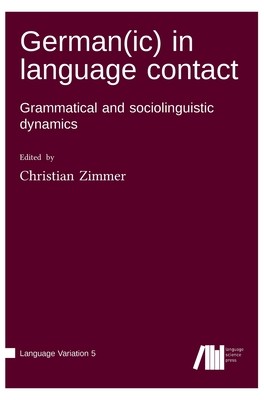
- We will send in 10–14 business days.
- Publisher: Language Science Press
- ISBN-10: 3985540098
- ISBN-13: 9783985540099
- Format: 17 x 24.4 x 1.4 cm, kieti viršeliai
- Language: English
- SAVE -10% with code: EXTRA
German(ic) in language contact (e-book) (used book) | bookbook.eu
Reviews
Description
It is well-known that contact between speakers of different languages or varieties leads to dynamics in many respects. From a grammatical perspective, especially contact between closely related languages/varieties fosters contact-induced innovations. The evaluation of such innovations reveals speakers' attitudes and is in turn an important aspect of the sociolinguistic dynamics linked to language contact. In this volume, we assemble studies on such settings where typologically congruent languages are in contact, i.e. language contact within the Germanic branch of the Indo-European language family. Languages involved include Afrikaans, Danish, English, Frisian, (Low and High) German, and Yiddish. The main focus is on constellations where a variety of German is involved (which is why we use the term 'German(ic)' in this book). So far, studies on language contact with Germanic varieties have often been separated according to the different migration scenarios at hand, which resulted in somewhat different research traditions. For example, the so-called Sprachinselforschung (research on 'language islands') has mainly been concerned with settings caused by emigration from the continuous German-speaking area in Central Europe to locations in Central and Eastern Europe and overseas, thus resulting in some variety of German abroad. However, from a linguistic point of view it does not seem to be necessary to distinguish categorically between contact scenarios within and outside of Central Europe if one thoroughly considers the impact of sociolinguistic circumstances, including the ecology of the languages involved (such as, for instance, German being the majority language and the monolingual habitus prevailing in Germany, but completely different constellations elsewhere). Therefore, we focus on language contact as such in this book, not on specific migration scenarios. Accordingly, this volume includes chapters on language contact within and outside of (Central) Europe. In ad
EXTRA 10 % discount with code: EXTRA
The promotion ends in 23d.05:54:34
The discount code is valid when purchasing from 10 €. Discounts do not stack.
- Publisher: Language Science Press
- ISBN-10: 3985540098
- ISBN-13: 9783985540099
- Format: 17 x 24.4 x 1.4 cm, kieti viršeliai
- Language: English English
It is well-known that contact between speakers of different languages or varieties leads to dynamics in many respects. From a grammatical perspective, especially contact between closely related languages/varieties fosters contact-induced innovations. The evaluation of such innovations reveals speakers' attitudes and is in turn an important aspect of the sociolinguistic dynamics linked to language contact. In this volume, we assemble studies on such settings where typologically congruent languages are in contact, i.e. language contact within the Germanic branch of the Indo-European language family. Languages involved include Afrikaans, Danish, English, Frisian, (Low and High) German, and Yiddish. The main focus is on constellations where a variety of German is involved (which is why we use the term 'German(ic)' in this book). So far, studies on language contact with Germanic varieties have often been separated according to the different migration scenarios at hand, which resulted in somewhat different research traditions. For example, the so-called Sprachinselforschung (research on 'language islands') has mainly been concerned with settings caused by emigration from the continuous German-speaking area in Central Europe to locations in Central and Eastern Europe and overseas, thus resulting in some variety of German abroad. However, from a linguistic point of view it does not seem to be necessary to distinguish categorically between contact scenarios within and outside of Central Europe if one thoroughly considers the impact of sociolinguistic circumstances, including the ecology of the languages involved (such as, for instance, German being the majority language and the monolingual habitus prevailing in Germany, but completely different constellations elsewhere). Therefore, we focus on language contact as such in this book, not on specific migration scenarios. Accordingly, this volume includes chapters on language contact within and outside of (Central) Europe. In ad


Reviews